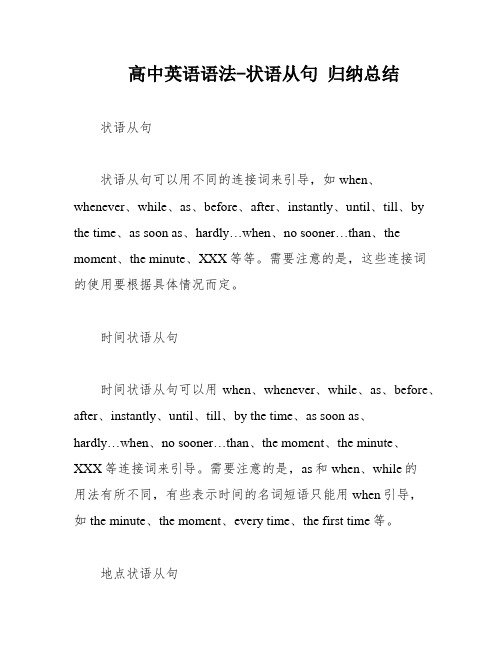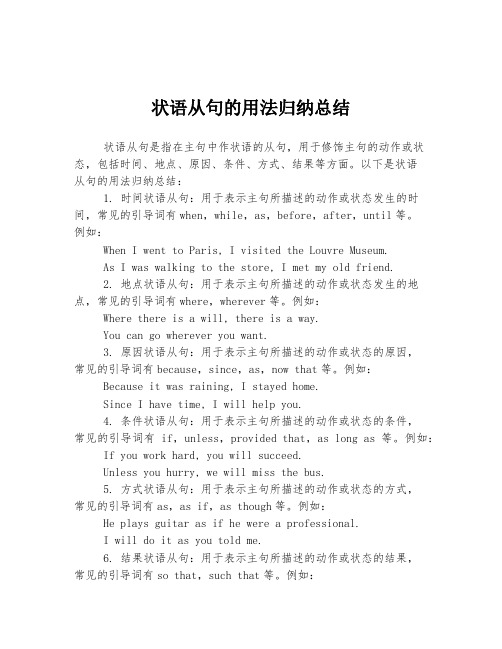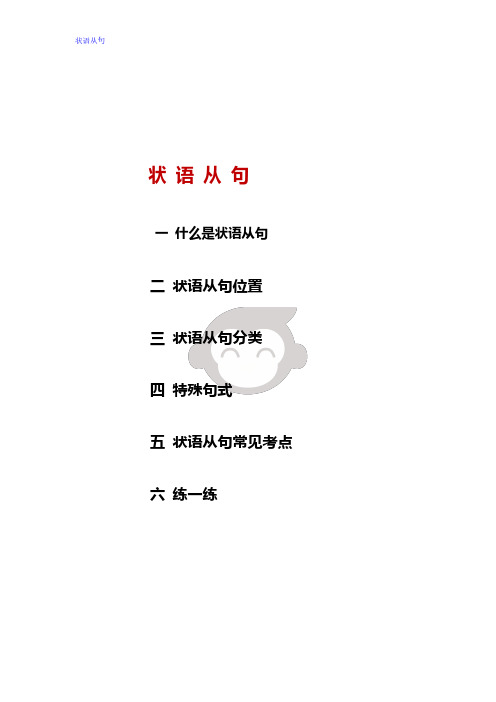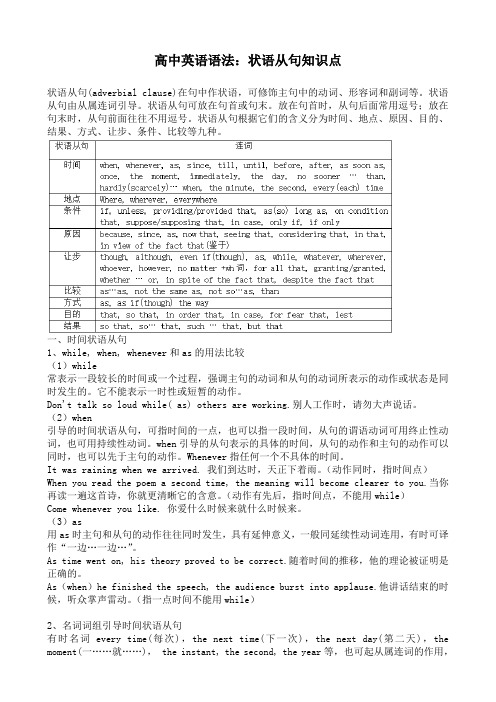高中英语语法-状语从句 归纳总结
高中英语语法总结之状语从句(共37张ppt)

• Difficulties are nothing if we are not afraid of them.如果我们不怕困难,困难就算不了什 么了。
• We shall go there tomorrow unless it rains. = We shall go there tomorrow if it doesn’t rain. 除非下雨,我们明天就去那里。
• Every time I travelled by boat, I got seasick.我 每次乘船都晕船。
• The moment I heard the song, I felt cheerful. 我一听到这首歌,就感到很愉快。
• Next time you come ,you’ll see him.下次你来 的时候,就会见到他。
• We were not tired though (although) we had worked all day.虽然我们干了一天活,但并 不累。
• (2)even if, even though(even if 和even though的意思为“即使”“纵使”有退一步 设想的意味,多用于书面语中)。
• 5、结果状语从句:
• (1)so that,so…that(so that前有逗号为 结果状语从句,so…that的so后面跟形容词 或副词)。
• We turned up the radio, so that everyone heard the news.我们把收音机的音量放大, 大家都听到了新闻。
• Seeing (that) he was badly ill, we sent for the doctor.鉴于他病情严重,我们派人去请医生 去了。
高中英语语法-状语从句 归纳总结

高中英语语法-状语从句归纳总结状语从句状语从句可以用不同的连接词来引导,如when、whenever、while、as、before、after、instantly、until、till、by the time、as soon as、hardly…when、no sooner…than、the moment、the minute、XXX等等。
需要注意的是,这些连接词的使用要根据具体情况而定。
时间状语从句时间状语从句可以用when、whenever、while、as、before、after、instantly、until、till、by the time、as soon as、hardly…when、no sooner…than、the moment、the minute、XXX等连接词来引导。
需要注意的是,as和when、while的用法有所不同,有些表示时间的名词短语只能用when引导,如the minute、the moment、every time、the first time等。
地点状语从句地点状语从句可以用where或XXX来引导。
其中,where 表示某一个地方,而XXX则表示任何一个地方。
原因状语从句原因状语从句可以用because、since、for、as、now that等连接词来引导。
需要注意的是,because语气最强,用来说明人所不知的原因,回答why提出的问题。
而as和since则用来说明显而易见的或已为人们所知的原因。
如果由because引导的从句放在句末并且前面有逗号,则可以用for来代替。
而now that则表示“既然”,需要注意它只能用于现在发生的情况,而since可以用于现在和过去。
条件状语从句条件状语从句可以用if、unless、once、in case、as long as、on n that等连接词来引导。
需要注意的是,多用一般时态,如果表示一般将来的情况,就用一般现在时,如果表示过去将来的情况,就用一般过去时。
高中英语语法状语从句归纳总结

状语从句一.二.分类:adv.+that (如此……以致) so that (结果……)such+n.+that (如果……以致) that (所以,因此)让步状语从句: though/although 不可同but 连用。
though/although (虽然) however (可是) even though/if (即使)no matter+what/which/where/who/when =whatever/whichever/wherever/whoever/whenever(不论什么/哪一个/哪里/谁/何时)比较状语从句: as (正如) as…as (和……一样) not as/so … as (不如……) than (比……更)the+比较级…+the+比较级 (越……越……)条件状语从句: if (假设) unless (如果不) so long as (只要) on condition that (如果)方式状语从句: as (像……那样地) just as (正像) as if (好像)as though (好像)三.四. 各种状语从句的简化方法:1.2.以after和before引导的状语从句的主语若与主句主语一致时,从句等于after/before+doing sth.作状语。
例:After she sang,she left the rich man's house.= After singing,she left the rich man's house.3.4.以as soon as引导的状语从句的主语若与主句主语一致时,从句等于on+doing sth.,作状语,此时的动词为非延续性动词。
例:Mary began to operate on the wounded soldiers as soon as he arrived at the village.= Mary began to operate on the wounded soldiers on arriving at the village.5.6.时间状语从句和条件状语从句的主语和主句主语一致时,有时可简化为不定式作状语。
状语从句的用法归纳总结

状语从句的用法归纳总结状语从句是指在主句中作状语的从句,用于修饰主句的动作或状态,包括时间、地点、原因、条件、方式、结果等方面。
以下是状语从句的用法归纳总结:1. 时间状语从句:用于表示主句所描述的动作或状态发生的时间,常见的引导词有when,while,as,before,after,until等。
例如:When I went to Paris, I visited the Louvre Museum.As I was walking to the store, I met my old friend.2. 地点状语从句:用于表示主句所描述的动作或状态发生的地点,常见的引导词有where,wherever等。
例如:Where there is a will, there is a way.You can go wherever you want.3. 原因状语从句:用于表示主句所描述的动作或状态的原因,常见的引导词有because,since,as,now that等。
例如:Because it was raining, I stayed home.Since I have time, I will help you.4. 条件状语从句:用于表示主句所描述的动作或状态的条件,常见的引导词有if,unless,provided that,as long as等。
例如:If you work hard, you will succeed.Unless you hurry, we will miss the bus.5. 方式状语从句:用于表示主句所描述的动作或状态的方式,常见的引导词有as,as if,as though等。
例如:He plays guitar as if he were a professional.I will do it as you told me.6. 结果状语从句:用于表示主句所描述的动作或状态的结果,常见的引导词有so that,such that等。
高中英语【语法归纳】状语从句

状语从句状语从句一什么是状语从句二状语从句位置三状语从句分类四特殊句式五状语从句常见考点六练一练一什么是状语从句状语从句是行使状语功能的从句,因为其作用相当于副词,它可以用来修饰谓语、定语、状语或整个句子。
状语从句通常由一个连接词或起连接词作用的词组引导。
二状语从句位置比较灵活,有时可以放于句首,有时可以置于句末。
状语从句位于句首时,其后常用逗号与后面的句子隔开。
三状语从句分类状语分类常用连接词例句时间状语after,before,when,while,whenever,as soonas,the moment,as,since,until,the minute,the second,immediately,directly,instantly The ball goes up very high after it hits the ground.Wait until you’re called.地点状语where,wherever You can take a walk wherever you liketo.原因状语Because,as,since,now that,seeing(that)considering(that),Since you do not understand,I will explain again.结果状语so that,such that He is so young that he can’t go to work.目的状语so that,in order that Speak clearly so that they mayunderstand you.条件状语if,unless,as(so)long as,once,unless,on condition that,in case He will do anything as long as it is interesting.让步状语though,although,even though,whilewhether,whoever/no matterwho,whatever/no matter what,whenever/ no matter Even though you say so,I do not believe it.比较状语than as…as,the more…the more The more I see him,the less I like him.方式状语as,as if,as though He told me everything as if I were hisbest friend.四特殊句式1时间状语中A:It+be+时间点+when……当某事发生时是什么时候It was11:00PM when he came back last night.B:It is/has been+时间段+since……自从某事发生后已过了多久时间It is/has been two years since I entered the the senior school.C:It+be+时间段+before……在某事发生之前需要多久时间It was8years before we finally drove away the Japanese invaders.It might be a long time before Chinese land on the moon.2让步状语从句A:as引导的让步状语从句,从句的表语、状语必须前置到句首。
完整版英语语法状语从句的归纳总结

在复合句中修饰主句或主句中的某一成分的从句叫状语从句。
状语从句通常由从属连词或起连词作用的词组引导,有时甚至不需要连词直接和主句连接起来。
状语从句根据它表达的意思不同,可分为时间、地点、原因、目的、结果、条件、方式、比较、让步等九类。
一、时间状语从句时间状语从句是表示时间关系的从句。
可以引导时间状语从句的连词很多,根据意义和主从句之间的时间关系,通常可分为以下几种情况:A.when, while, as, wheneverwhen, while, as 表示主句谓语作和从句的谓语动作同时发生或几乎同时发生。
1 .when①when表示点时间时,从句中用短暂性动词;表示段时间时,用持续性动词。
When I got home, my family were already having dinner.我到家的时候,全家已在吃晚饭。
(whe n表示点时间)When they were still talking and laughing, the teachercame in.当他们还在说笑的时候,老师进来了。
(when表示段时间)He waved a hello when he saw her.当他看见她的时候,就挥手打了个招呼。
(when表示点时间)When you think you know nothing, you begin to know something. 当你认为自己一无所知的时候,就开始知道一些事情了。
(when表示段时间)注意:当when意思是正当...... 时候(and at that moment )时,when只能跟在前一分句之后。
He was about to go to bed whenthe doorbel rang. 他正要上床,忽然门铃响了。
They were watching the World Cup when suddenly the lights went out.他们正看着世界杯比赛,突然灯灭了。
高考英语语法知识点归纳总结_状语从句

的
状
从
that
so that
in order that=to the end that
lest = for fear that
I shall write down your telephone number that I may not forget.
We’ll tell you the truth so that you can judge for yourself.
不是说明直接原因,而是对某种情况加以推断,用于表示补充说明理由。
as
As he didn’t know much English, he looked up the word in the dictionary.
As语气最弱,其原因只是对结果的附带说明。从句常放在句首,说明原因,主句说明结果,常用于口语中。
Now(that) everybody is here, let’s begin.
seeing (that), now that, considering that和since, as意义相似,他们都有“鉴于某个事实”的意思,that可以省去in that中that不能省略。now that用来说明一种新情况,然后加以推论,位于句首时,that可以省略。
while做并列连词,表示相对关系“然而”
While I understand your point of view, I don’t share it.
While引导让步状语从句,相当于although,但一般位于主句之前。
While there is life, there is hope.
While引导条件状语从句,相当于as/so long as,翻译成“只要”
高中英语语法:状语从句知识点

高中英语语法:状语从句知识点状语从句(adverbial clause)在句中作状语,可修饰主句中的动词、形容词和副词等。
状语从句由从属连词引导。
状语从句可放在句首或句末。
放在句首时,从句后面常用逗号;放在句末时,从句前面往往不用逗号。
状语从句根据它们的含义分为时间、地点、原因、目的、结果、方式、让步、条件、比较等九种。
一、时间状语从句1、while, when, whenever和as的用法比较(1)while常表示一段较长的时间或一个过程,强调主句的动词和从句的动词所表示的动作或状态是同时发生的。
它不能表示一时性或短暂的动作。
Don't talk so loud while( as) others are working.别人工作时,请勿大声说话。
(2)when引导的时间状语从句,可指时间的一点,也可以指一段时间,从句的谓语动词可用终止性动词,也可用持续性动词。
when引导的从句表示的具体的时间,从句的动作和主句的动作可以同时,也可以先于主句的动作。
Whenever指任何一个不具体的时间。
It was raining when we arrived. 我们到达时,天正下着雨。
(动作同时,指时间点)When you read the poem a second time, the meaning will become clearer to you.当你再读一遍这首诗,你就更清晰它的含意。
(动作有先后,指时间点,不能用while)Come whenever you like. 你爱什么时候来就什么时候来。
(3)as用as时主句和从句的动作往往同时发生,具有延伸意义,一般同延续性动词连用,有时可译作“一边…一边…”。
As time went on, his theory proved to be correct.随着时间的推移,他的理论被证明是正确的。
As(when)he finished the speech, the audience burst into applause.他讲话结束的时候,听众掌声雷动。
- 1、下载文档前请自行甄别文档内容的完整性,平台不提供额外的编辑、内容补充、找答案等附加服务。
- 2、"仅部分预览"的文档,不可在线预览部分如存在完整性等问题,可反馈申请退款(可完整预览的文档不适用该条件!)。
- 3、如文档侵犯您的权益,请联系客服反馈,我们会尽快为您处理(人工客服工作时间:9:00-18:30)。
状语从句
一.分类:
such+n.+that(如果……以致)that(所以,因此)
让步状语从句:though/although不可同but连用。
though/although (虽然)however (可是)even though/if(即使)
no matter+what/which/where/who/when =whatever/whichever/wherever/whoever/whenever
(不论什么/哪一个/哪里/谁/何时)
比较状语从句:as (正如)as…as(和……一样)not as/so … as (不如……)than(比……更)the+比较级…+the+比较级(越……越……)
条件状语从句:if(假设)unless(如果不)so long as(只要)on condition that (如果)
*
方式状语从句:as(像……那样地)just as(正像)as if(好像)as though(好像)
二.各种状语从句的简化方法:
1
作状语。
】
例:After she sang,she left the rich man's house.= After singing,she left the rich man's house.2.以as soon as引导的状语从句的主语若与主句主语一致时,从句等于on+doing sth.,作状语,此时的动词为非延续性动词。
例:Mary began to operate on the wounded soldiers as soon as he arrived at the village.
= Mary began to operate on the wounded soldiers on arriving at the village.
3.时间状语从句和条件状语从句的主语和主句主语一致时,有时可简化为不定式作状语。
例:She stopped when she saw her husband.= She stopped to see her husband.If you want to understand the farmers,you must go to the countryside.
= To understand the farmers,you must go to the countryside.
4.结果状语从句和目的状语从句的主语与主句主语一致时,可以简化为不定式作状语;若两者主语不一致时,则应简化为不定式的复合结构作状语。
例:He was so tired that he couldn't go any further.= He was too tired to go any further.
I came here so that I could ask some questions.= I came here(in order) to ask some questions.5.以when,while引导的时间状语从句和以if引导的条件状语从句的主语若与主句主语一致时,从句等于when/while/if +doing sth.作状语,表示谓语动作发生在该状语动作的进行过程之中。
例:When he turned on the radio,he found it broken.= When turning on the radio,he found it broken.While she was walking along the street,she was hit by a car.= While walking along the street,she was hit by a car.
6.原因状语从句的主语与主句主语一致时,可简化为分词短语作状语。
例:Since l didn't know Chinese,I tried to speak to her in English.= Not knowing Chinese,I tried to speak to her in English.
注意:形容词短语也可作表示原因的状语,来代替原因状语从句,放在句首、句末均可,但一般应加逗号。
例:As he was thirsty and eager to get a little rest,he went into the tea-house.
= Thirsty and eager to get a little rest,he went into the tea-house.
7.在时间、原因、条件等状语从句中,若从句和主句主语不一致时,可简化为分词复合结构作状语。
有时也可简化为“with/without名词或代词十分词(短语)”形式作状语。
例:When the film start appeared, the children got exited.= The film start appearing,the children got exited.
If all the work is done, you can have a rest.= With all the work done,you can have a rest.
Nothing can live if there is no air.= Nothing can live without air.
8.让步状语从句的主语与主句主语一致时,可简化为分词短语作状语;不一致时,常简化为with 或in spite of介词短语作状语。
例:Although he faced his death,he didn't say anything before the enemy.
= Facing the death,he didn't say anything before the enemy.
Although there was danger,he rushed out to carry the boy to safety.
= In spite of danger,he rushed out to carry the boy to safety.
*
三.表示"一…就…"的结构
hardly/scarcely…when/before, no sooner…than和as soon as都可以表示"一…就…"的意思,例:I had hardly / scarcely got home when it began to rain.
I had no sooner got home than it began to rain.
As soon as I got home, it began to rain.
注意:如果hardly, scarcely 或no sooner置于句首,句子必须用倒装结构:
Hardly / Scarcely had I got home when it began to rain.
No sooner had I got home than it began to rain.
四.As引导的让步状语从句的倒装:
$
1.形容词+as+主语+系动词:
例:Tired as he is, he offers to help me. 尽管他已经很累了,他还是主动提出帮助我。
2.过去分词+as+主语+系动词:
例:Well-known as the book is, the author is not satisfied and prepared to revise it.
尽管这本书写得很好,作者还是不满意并打算修改它。
3.名词+as+主语+系动词:
例:Student as he is, he does not study hard. 他虽然是个学生,但却不努力学习。
4.副词+as+主语+谓语部分:
例:Much as I admire his courage, I don’t think he acted wisely.
我虽然钦佩他的勇气,但我认为他这样做是不明智的。
5.动词原形+as+主语+谓语的剩余部分:
例:Try as you will,you won’t be able to persuade him. 不管你怎么努力,你都说服不了他。
